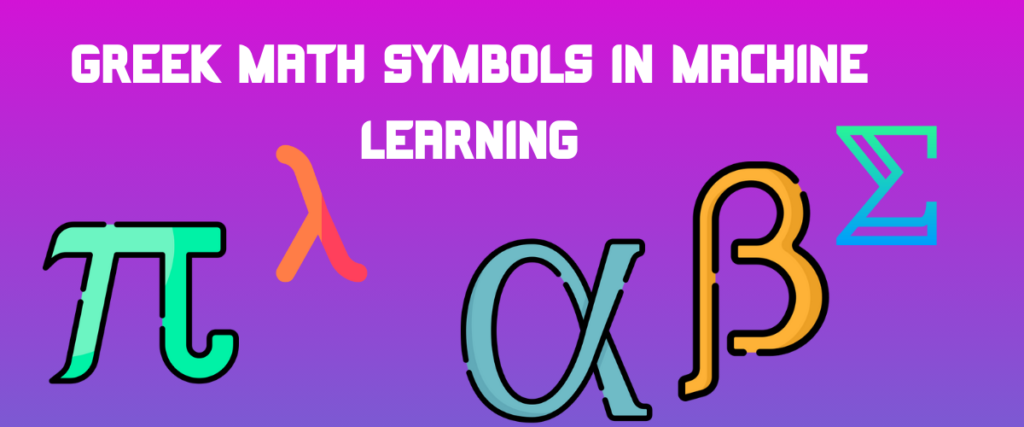Mathematics, a field rich in diversity and applications, uses various notations for different measurements in both mathematics and physics. We cannot use the same notation for every measurement we conduct in mathematics and physics, right?
To solve this problem, the Greek Mathematicians have introduced the Greek Math symbols for each measurement or variable representing the quantities.
These symbols are not only used in mathematics but also in Physics ranging from their usage in Nuclear Physics to the measurement of angular frequency, these symbols are widely used in mathematics, science, and engineering.
They also find their use in technology, especially in new-age tech like Machine Learning. The objective of this post is to look at all the possible math symbols used in machine learning and statistics, along with short explanations.
Overview of Greek Symbols in Machine Learning
There are various math symbols represented by Greek letters according to the official Wikipedia page. All the symbols can be seen in the picture below.

While these symbols have different meanings in maths and science, some of these symbols can be seen in Machine Learning courses and reference books.
Greek Symbols: Their Role in Machine Learning
Let us take a look at all the symbols being used in Machine Learning and its sub-branches.
The descriptions provided below must not be confused with actual meaning and values of the symbols in mathematics and physics. We are only focusing on where we get to see these symbols in machine learning.
Pi(π)
Wonder how the symbol pi is used in Machine Learning? While there is no concrete use of pi in ML, we can find the usage of pi in Reinforcement Learning. To explain it briefly, in reinforcement learning the agent follows a policy that provides a maximum reward in the environment. The policy is generally represented by π.
Omicron(Ο)
While this symbol is not directly used in Machine Learning, it is used in data structures and algorithms(DSA) as an upper-bound notation to determine the complexity of algorithms. DSA is often used as a prerequisite to mastering machine learning.
Omega(Ω)
Like Omicron, Ω is also used in DSA to represent the lower bound notation to determine the complexity of the algorithms.
Alpha(α)
Alpha is one of the most popular hyperparameters in training machine learning and deep learning models. Also known as the learning rate parameter, it is used to determine how well or fast the model learns the training data. This parameter is tunable, which means it can be modified according to the model’s requirement. It can also be seen in off-policy reinforcement learning algorithms like Q-Learning and SARSA as a learning rate parameter.
Beta(β)
Linear regression is the first model any beginner has ever built. Coming to the formula of linear regression, β is used as a regression coefficient. The formula for linear regression is given as follows:

Gamma(γ)
Gamma is used as a hyperparameter concerning non-linear support vector machine(SVM). It determines how a single training example influences the decision boundary.
Coming back to reinforcement learning, gamma can also be seen as a discount factor in Q-Learning and SARSA. The discount factor determines the reward for future actions.
Delta(δ and Δ)
The capital and small delta(Δ and δ) can be found in Machine Learning.
Δ: The capital delta is used in something called a Delta rule, which utilizes the gradient descent learning rule to update the weights of the inputs of a neural network.
δ: In backpropagation, δ is used to indicate the gradient of loss for the output of a neuron. This error plays an important role in updating the weight of the neuron.
Eta(η)
Sometimes η is also used to represent the learning rate, especially in the backpropagation algorithm.
Lambda(λ)
Sometimes, we need to introduce a regularization (penalty) term to control the overfitting of a deep learning model. Lasso(L1) and Ridge(L2) are the two types of regularization techniques. In these techniques,λ is used as the regularization parameter.
Sigma(Σ and σ)
Σ: As we all know, Σ is used as a summation of a set of values. In machine learning too, this symbol is used to represent the sum of a certain number of entities.
σ: In statistics, this symbol is used to represent the variance and standard deviation of a distribution. In machine learning, σ denotes the sigmoid function popular for its S-shaped curve.
Phi(φ)
Most frequently in deep learning algorithms, we will get to see this symbol to represent the activation function used to activate a neuron. The different types of activation functions are sigmoid, ReLU, and Leaky ReLU.
Wrapping it Up
The Greek math symbols are used to represent the measurements conducted in maths and physics, but we can see these symbols in other domains of course with different meanings. In this post, we have discussed the instances where we get to see these symbols in machine learning. How might the evolution of machine learning influence the usage of these ancient symbols in future technologies?
